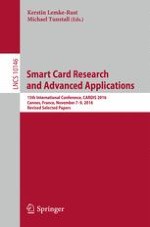
2017 | OriginalPaper | Buchkapitel
Kernel Discriminant Analysis for Information Extraction in the Presence of Masking
verfasst von : Eleonora Cagli, Cécile Dumas, Emmanuel Prouff
Erschienen in: Smart Card Research and Advanced Applications
Aktivieren Sie unsere intelligente Suche, um passende Fachinhalte oder Patente zu finden.
Wählen Sie Textabschnitte aus um mit Künstlicher Intelligenz passenden Patente zu finden. powered by
Markieren Sie Textabschnitte, um KI-gestützt weitere passende Inhalte zu finden. powered by